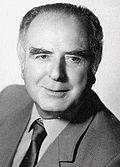This article relies largely or entirely on a single source .(October 2022) |
| Minister for European Affairs | |
|---|---|
| Ministro per gli Affari Europei | |
| Department for European Politics | |
| Member of | Council of Ministers |
| Reports to | The prime minister |
| Seat | Rome |
| Appointer | The president |
| Term length | No fixed term |
| Formation | 4 April 1980 |
| First holder | Vincenzo Scotti |
| Website | www |
The minister for European affairs (Italian : ministro per gli affari Europei) in Italy is one of the positions in the Italian government, head of the Department for European Policies. [1]
Contents
The current minister for European affairs is Tommaso Foti, of the Brothers of Italy party, who is serving since 2 December 2024.






























